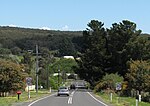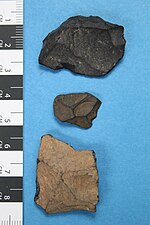Glenlyon is a small village in the Shire of Hepburn local government area, Victoria, Australia around 10 km from Daylesford along the Daylesford–Malmsbury Road, and around 101 km from the Melbourne CBD via Kyneton and Malmsbury.
It is on the Loddon River.
Glenlyon is well known for its main street of old European trees lending an "Englishness" to the village and providing a cooling canopy in the heat of summer.
As at the 2016 Commonwealth Census, the village of Glenlyon & its immediate hinterland (the census district includes the localities/hamlets of Denver, Porcupine Ridge, parts of Wheatsheaf) had a population of 389 people. The median age of the local population is 50 as of 2011. The top 5 cultural backgrounds of the local population are broken up into 30% claiming English heritage, 20% Australian heritage, 13.5% Irish, 11.9% Scottish and 3.3% Germany—however, of these numbers, 74.9% were actually born in Australia, 5.8% in England and 3% in New Zealand. 84.7% only spoke English at home. A reflection of the village as the location of many commuters to either Daylesford, Ballarat or even Melbourne and reflecting the fact that the locale is a popular retirement, weekender, holiday home or hobby farm location is that 44.1% are employed in professional or managerial roles with 13.9% as tradesmen and 21.9% as clerical or public servants. Only 6.6% work in rural or farming.Glenlyon has a rich agricultural industry amongst the surrounding areas. Cattle and sheep are largely stocked throughout the district supplying meat products and wool to the local and global markets. Potatoes, cereal crops (both for hay and grain), organic vegetables, vegetable seed and lucerne grow in the rich volcanic soil. The contrast of green pastures, grazing livestock, bright red ploughed paddocks and golden stubble paddocks across the rolling countryside, make the scenery in the area very special to the locals and visitors alike.







